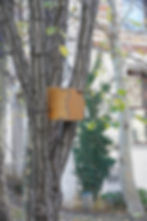
Reserved Split
2021
Tasarım ve Uygulama Ekibi:
Begüm Nizam, Büşra Doymuş, Beyza Ünal, Sena Miray Çakan
Proje Yürütücüleri:
Ayşe Hilal Uğurlu, Kürşad Özdemir
Project Asistanları:
Begüm Nar, Berfin Az, Elif Lahor, Enes Kaya, Sümeyye Nur Öztürk
Uygulama Desteği:
Proje Destekçileri:
Baba Yapı, TORID
Reserved Split is a nest design for Zebra finches. They are often known as noisy and restless animals. They travel in colonies and value the privacy of their habitat. Therefore, the entrances of the nests are hidden at the corner of the nest as triangular slits that only Zebra finches could enter. Thus, other bird species and animals cannot enter the nests. Nests are designed compatible with both urban and natural contexts with the adaptable connection part.
Zebra finches are 10 cm long and weigh 12 grams. They are social animals that are noisy and constantly in motion. They usually travel in 50-100 bird colonies, leave each other for a while and reunite. During breeding periods, they nest and incubate; male and female birds change shifts in the process. Hatched nestlings continue to live in the nest with their families until they learn to fly. When they learn to fly and hunt, they leave the nest.
One of the main principles of the design is the maximum use of natural materials, thus minimizing screws. As a result, the design is shaped around wood joineries. Entrances of the nests are placed to the corners and sized according to the size of Zebra Finches to prevent invasion of the nests by other bird species and animals. The faces of the nest are angled to increase possible positions on the tree instead of a traditional roof shape. In this way, people can position the nest as they wish by considering that this bird species loves the sun.
- Females lay eggs in May.
- They spend 21 days in the nest. During this time, the female takes care of the nest and eggs; the male collects most of the food.
- The female lays a total of four to six eggs in the nest.
- They have an incubation period of 14 days. Young Zebra finches lay 2 to 3 eggs, but older birds’ number of eggs can reach up to 6.
- Nestlings learn how to live from their parents in the nest. After three weeks - in the second half of June, the nestling learns flying and hunting. And then they leave the nest.
- When they leave the nest, it is time for the nest to be cleaned.
Reserved Split hint bülbülleri için bir yuva tasarımıdır. Hint bülbülleri gürültücü ve hareketli kuşlar olarak bilinirler. Koloni halinde gezerler ve yaşam alanlarının gizliliği onlar için önemlidir. Bu sebeple, yuvaların giriş kısmı için köşelerde hint bülbüllerinin girebileceği ölçülerde üçgen yarıklar oluşturuldu. Bunu yaparak, başka türdeki kuşlar ve hayvanlar bu yuvaların içerisine girmesinin önüne geçildi. Yuvaların hem kent içerisinde hem de ormanda da kurulabilir özellikte olmasına dikkat edildi.
Hint bülbüllerinin boyları 10 cm, ağırlığı ise ortalama 12 gramdır. Sosyal canlılar olan hint bülbülleri sürekli hareket halinde olup, gürültü çıkaran kuş türlerindendir. Genelde 50-100 kuşluk koloniler halinde gezip, belli süreyle birbirlerinden ayrılıp tekrar bir araya gelirler. Üreme dönemlerinde yuvalarına yerleşip kuluçka dönemine girerler. Yuvada yumurta varken erkek ve dişi kuş arasında sürekli nöbet değişimi olur. Yumurtadan çıkan yavru uçmayı öğrenene dek ailesiyle yuvada yaşamaya devam eder. Yavru artık uçmayı ve avlanmayı öğrendiğinde ise yuva dağılır.
Yuvanın ana tasarım ilkelerinden birisi olabildiğince doğal malzeme kullanmak, dolayısıyla vida kullanımını minimuma indirmektir. Bu sebeple sistem geçme sistemler ile oluşur. Yuvaların girişleri hint bülbüllerinin girebileceği boyutlar gözetilerek köşelere yerleştirildi. Bu şekilde, yuvanın başka türler tarafından işgal edilmesini önlendi. Yuvanın yüzeylerine çeşitli açılar verilerek, yuvanın ağaçta istenilen şekilde konumlandırılabilmesi sağlanır. Konumlandırmada, hint bülbülünün güneşli alanlarda vakit geçirdiği gözününde bulundurulmalıdır.
- Mayıs ayında dişiler yumurtlar.
- Yuvada 21 gün geçirirler. Bu süre zarfında çoğunlukla dişi yavru ile ilgilenir ve erkek yiyecek toplar.
- Dişi yuvaya dört ila altı yumurta bırakır. Bunlar birkaç gün içinde serilir.
- 14 gün gibi bir kuluçka döneminde genç Hint bülbülleri 2 ila 3 yumurta bırakırken yaşlı olanların bıraktığı yumurta sayısı 6’yı bulabilir.
- Kuşlar yuvadan çıktıktan sonra ebeveynlerinden yuva içerisinde yaşamayı öğrenirler. Haziranın ikinci yarısında, yavru artık uçmayı ve avlanmayı öğrenir. Ardından yuva dağılır ve artık yuvaya gerek kalmaz.
- Yuva terk edildiğinde sıra yuvanın temizlenmesine gelir.






